Cause Map Overview
At ThinkReliability, we live by the philosophy that the only reason to dispute causes is lack of evidence. But when it comes to some historical concepts, we understand that we may not have that evidence immediately at hand. For example, finding the defining moment when terrorism began or pinpointing why it ever started in the first place would take a rather impressive Cause Map.
What we can say is that there was a renewed focus on the concept of terrorism and potential preventative solutions to terrorist incidents after 9/11. And, in spite of renewed focus, terrorist incidents have still unfolded and some rather frightening near miss incidents have occurred, too.
These individual incidents are worthy of extensive cause mapping because they give us insight into the way modern terror events actually unfold, thereby expanding our list of potential solutions.
According to John Mueller’s Terrorism Since 9/11: The American Cases, there have been at least fifty terrorism incidents in the US since 9/11, ranging from plots to realized attacks. And these incidents do not include terrorism attempts and “successes” from the rest of the world.
Christmas Cheer Turns Christmas Fear
As for the attempted bombing on Flight 253, a man suspected of terrorism was able to board Flight 253 from Amsterdam to Detroit on Christmas day (2009) with 80 grams of explosives and a liquid detonator. The device did not detonate, likely saving the plane.
However, a passenger and the suspect were burned. And had the explosives gone off, the plane, along with nearly 300 people, would likely have been lost.
To further define the issue, we turn to our Cause Map.
Cause Mapping Step #1: Define the Problem
Defining the Problem of the Near Miss Explosion on Flight 253
Cause Mapping any incident, terrorism-related or otherwise, requires first asking four questions:
What is the problem?
It’s unlikely you would get a direct answer to this question. In fact, if you were Cause Mapping the incident with a group and asked for a cause, you would likely hear something like:
“The explosives were the issue.”
“It’s not so much the explosives, but allowing the suspected terrorist on the plane that caused the incident.”
“They should have cut off his visa. Without a visa, he would have been denied access to the plane and couldn’t have pulled off the bombing.”
While creating a Cause Map, we don’t judge the validity of any of the provided “problems”, but rather write them down and place them on a Cause Map to determine their usefulness in dissecting the issue.
When did it happen?
Cause Mapping requires pinpointing a date to see if something changed. It’s the “starting point” of the incident. The attempted bombing occurred on Christmas Day, December 25th, 2009. The exact time is unknown, but it was during the final approach from Amsterdam to Detroit. The obvious change here is that the suspect was allowed to board with explosives. Obviously this is (hopefully) atypical for the standard plane flight.
Where did it happen?
The incident occurred on Northwest Airlines Flight 253, which was an Airbus 330 on the final approach to Detroit’s airport.
How did it impact the goals?
Three main goals were impacted by this incident: Safety, Property and Customer Service. The airline industry is highly reliable, meaning the amount of annual fatalities is very low. Although everyone on the plane survived, there was certainly the potential for the loss of all onboard, which is an impact to the safety goal. The potential loss of life was 278 passengers and 11 crew members.
The property impact here is also fairly straightforward: The loss of the plane. Losing a plane would have cost an estimated $239.4 million.
The customer service goal is no less serious and impacted the organization on multiple levels. The failure to follow safety procedure negatively impacts the airline and the industry as a whole. The airline was also forced to provide vouchers for all passengers, and delays in service occurred.
The loss of life is our featured goal.
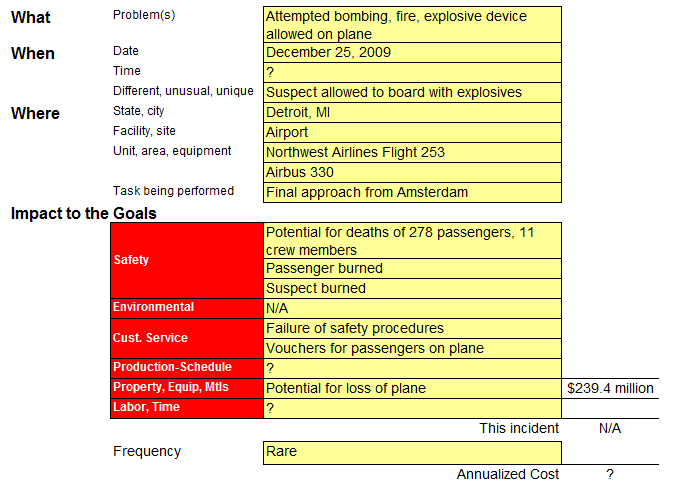
Cause Mapping Step #2: Identify the Causes
The Route the Explosives Took to Get on the Plane
For any Cause Map, writing down goals is a key starting point. But to figure out how the explosives got on the plane, we must add causes to our Cause Map by asking why they got there.
We start, as promised, with our safety goal. This goal is impacted because the lives of 278 passengers and 11 crew members were at risk.

We also know that the loss of life would have occurred due to the loss of the potential loss of the plane, which happens to be the impact to the property goal.
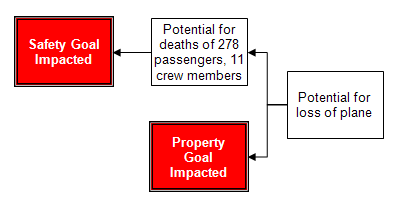
We know that the potential for losing the plane is caused by the potential for explosion as well as the potential for that explosion to actually damage the aircraft. We have evidence for one of those events—sufficient explosives— and place that evidence on the Cause Map below the cause for validation.
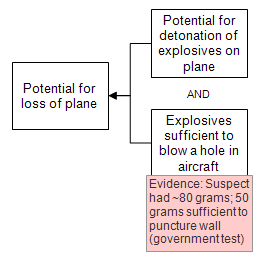
The potential for detonation of explosives on the plane is based on the potential for detonation (which we know in this case to be an unsuccessful detonation) and the suspect’s boarding of the plane with an explosive mixture. We have evidence for both on the cause map. Witnesses made statements regarding the unsuccessful detonation, detailing how the device burst into flames rather than setting off the explosives. As for the explosive mixture, the FBI confirmed the mixture to be pentaerythritol tetranitrate (PETN).
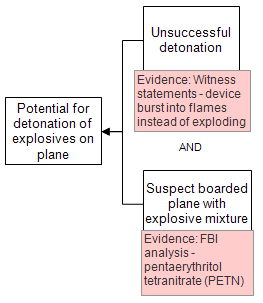
The unsuccessful detonation was a result of three causes, all connected and required. The suspect was subdued by other passengers, making detonation that much less likely. In addition, the flame was doused by flight attendants and other passengers. Finally, the suspect had trouble with the detonator that caused it to burst into flames rather than detonate.
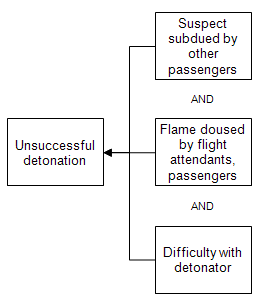
If we ask why the detonator was difficult to use, we arrive at an interesting turn of events. Two required events involved in the difficulty of using the detonator are that the suspect used a liquid detonator and liquid detonators have difficult aspects that make them harder to use. But the reason the suspect may have used a liquid detonator in the first place was to bypass airport security, as demonstrated by this part of the Cause Map.
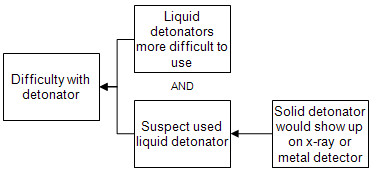
Now that the Cause Map has been drawn for how the unsuccessful detonation (the potential for detonation) occurred, we can look back at our third figure and determine why the suspect got on the plane in the first place.
There are two required causes for this part of the Cause Map. The suspect was allowed to board the plane and explosive ingredients were not detected by security.
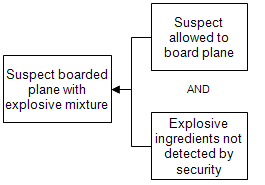
If we break these two causes into separate diagnosis we can see that the suspect was allowed to board the plane because his visa was not revoked and he was able to avoid being added to the no-fly list. The reason he was kept off the no-fly list is simple: There was insufficient evidence to add him to it. The no-fly list requires a standard of at least “Reasonable Suspicion”, meaning no one could be denied travel without that standard.
As for the suspect’s visa, officials in the US were unaware that the visa has been awarded by the US Embassy in London, a result of the London officials having issued the visa and not informed US officials. The suspect’s visa also remained intact because there was no follow up regarding information previously entered into TIDE, the international terrorist database. The lack of follow up resulted from either the procedure failing to require it or a failure to follow procedure.
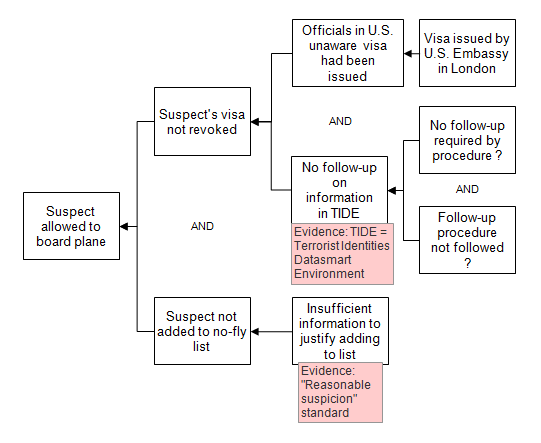
The last part of the Cause Map to dissect is the portion detailing not only with the failure to detect the explosive ingredients but also the Customer Service goal. These parts of the Cause Map are interconnected. The explosives were most immediately not detected because the ingredients were hidden under the suspect’s clothing and there was a failure of safety procedures.
The safety procedure issue stems from two immediate causes: the suspect was neither given additional screenings nor passed through a body scan. The screenings were skipped because the suspect was not added to the selectee list based on there being insufficient reason to add him to the list, as was evidenced by the “reasonable suspicion standard”. The suspect was not passed through a body scan because it is not allowed to be used by US passengers as a result of privacy issues.
This series of causes is detailed on the Cause Map as seen below.
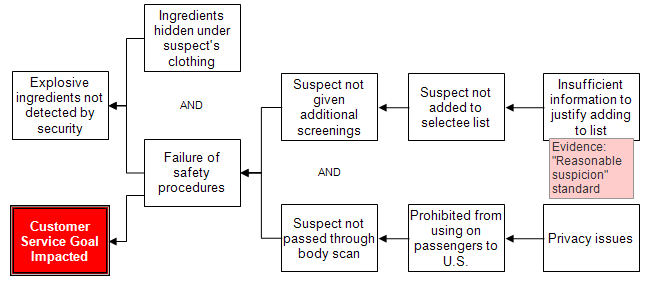
To better understand the cause map, it may help to download the cause map by clicking “Download PDF” at the top of the page.
How to Prevent the Detonation of Explosive Materials on Planes: Several Key Solutions
With a solid, creative Cause Mapping facilitation, the organizations involved could collect an incredibly high number of potential solutions. Even in cases of attempted terrorism, Cause Maps provide insight into the best available options for future prevention.
Solution #1: Create Procedure to Inform US Officials of Visa Issued in London
Better communication may have saved a world of trouble here. The Cause Map demonstrates this as a potential solution to the problem early on in the chain of events.
Solution #2: Create Procedure to Tighten TIDE Follow Up
The TIDE database could be a strong tool in preventing these kinds of scenarios. Procedural change might demonstrate how it could be properly used.
Solution #3: Change No-Fly List Standard
This solution deals with major policy change. But a Cause Map is meant to show all potential fixes, and this is a clear point of consideration.
Solution #4: Alter Security Procedures
Overall security procedures at the airport could be altered to include checks that could potentially detect liquid detonators. This is at the will of both policy and science.
Solution #5: Privacy Policy Changes
This would require a serious, in-depth discussion over government positions on privacy.
Solution #6: Change Selectee List Standard
If the suspect were identified earlier, he may never have boarded the plane. This is another policy consideration.
Our solution set, based on causes identified by the Cause Map, demonstrates a series of potential answers for how to reduce the risk of the incident occurring to an acceptable level. The discussion over what is acceptable is the one that follows successful Cause Map facilitation.
One key, if obvious note: some solutions may not cause enough of your problem to stay in the conversation for a long period of time. For example, “building a stronger plane” is probably not a good way to meet the Property Goal in this scenario, given the much more pressing need to preserve the lives of those on the plane.
Terrorist Cause Map Afterthoughts
Building a Cause Map for a terrorist incident helps pinpoint solutions, as was mentioned in the opening paragraph of this incident write up. One key consideration is the extra attention likely given to terrorism post-9/11 and the attention of detail/evidence given to isolated events. With additional evidence, we gain insights that make for a more detailed Cause Map. And with a more detailed cause map, we get better solutions.
Bring Cause Mapping® Root Cause Analysis training to your site
Schedule a workshop at your location to train your team on how to lead, facilitate, and participate in a root cause analysis investigation.
